Articles
| Name | Author |
|---|
Case Study: The Fuel Saving program and initiatives at Air Transat
Author: Gabriel M. Blanchette, Flight Operations Engineering Specialist, Air Transat
Subscribe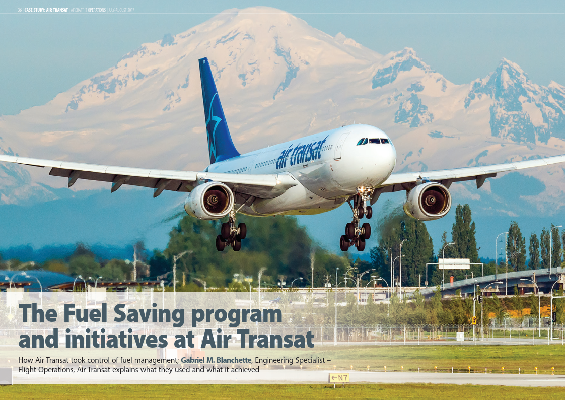
The Fuel Saving program and initiatives at Air Transat
How Air Transat took control of fuel management; Gabriel M. Blanchette, Engineering Specialist – Flight Operations, Air Transat explains what they used and what it achieved
This article will look at Air Transat’s fuel saving and fuel efficiency program and how our new software has helped us achieve better performance in this part of our business. But first, a brief introduction to Air Transat which is a leisure airline based in Montréal with bases also in Vancouver and Toronto. The main business operates some 20,000 charter and scheduled flights each year with a flexible fleet of 42 aircraft at the time of writing; 19 Boeing 737, 9 Airbus A310 and 14 Airbus A330.
FUEL EFFICIENCY AT AIR TRANSAT
Our fuel efficiency program really started in the early two thousands with an initial fuel management project in 2004 that ran until 2008 to mitigate against increasing fuel prices and which generated a number of fuel saving initiatives including ‘single engine taxi out’, and ‘idle reverse landing’. From 2008 until 2015, we continued with our active initiatives but with only limited tracking: we knew savings were possible but could not quantify them, it was difficult to establish what savings were being achieved. So, in 2015, Air Transat settled on a new software solution that would allow the airline to look further into what savings were being made, and for that we implemented Honeywell GoDirect Fuel Efficiency software which has been in use at Air Transat for the past two years.
The solution has already enabled Air Transat to track both past and new fuel saving initiatives. The next step in 2017 is that we are preparing to give fuel data to flight crews and dispatchers to allow them to be more involved in the fuel management program in order to help save even more fuel.
At Air Transat, fuel efficiency is a company-wide program in which everybody is involved and where Flight Ops work with Tech Ops and Ground Ops to drive fuel efficiency and to produce fuel savings. Some initiatives include…
- Flight Ops.
- In-flight and on-ground Fuel Conservation;
- Accurate Flight Planning;
- EFB solutions.
- Tech Ops.
- Engine water wash;
- Weight reduction.
- Ground Ops.
- Loading optimization;
- Potable water.
Air Transat has been recognized as one of the greenest airlines in North America for the past few years. Every year since 2012, Air Transat has been ranked number one in North America and one of the world’s leading airlines for its fuel efficiency and greenhouse gas emissions reduction by Atmosfair, a climate protection organization. We have also received a number of awards for our environmental performance.
Air Transat environmental credentials
- World`s first certified green airline;
- First airline in North America to get IATA IEnvA (IATA Environmental Assessment) certification;
- Environmental excellence awards from Quebec and municipal governments cargo associations and travel agent associations;
- First LEED EB platinum building in Canada;
- Most Sustainable HQ in North America list.
With that record, it comes naturally to us at Air Transat to make efforts to drive fuel efficiency and fuel savings and to get more out of our aircraft in that respect.
HONEYWELL GODIRECT – NEW EYES ON EFFICIENCY
Prior to the use of the Honeywell software, fuel initiatives at Air Transat were mainly based on best practices; things that were known in the industry as fuel savers but for which there could be only estimations as to what the savings would be because we were using generic values, poor data with limited means available to actually track what was happening. It was difficult to say whether the steps we had taken were working or not. There were also problems with data quality because our data was primarily coming from journey logs that had been completed manually and then processed into the system after the event making them difficult to track. In order to track any initiatives we might have put in place, we needed software that could ensure data would be of good quality and would enable tracking.
GoDirect Fuel Efficiency
The software used at Air Transat connects multiple sources (figure 1).
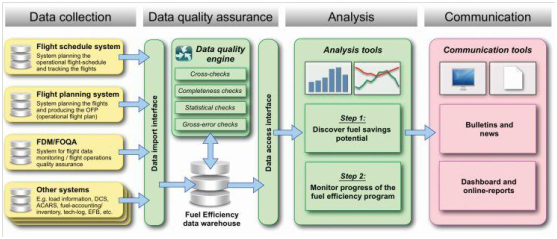
Figure 1
It collects Ops data from all of our flights and matches it to Flight Plan data and FDM (Flight Data Monitoring) data from the QAR (Quick Access Recorder), so that those three main data sources are delivering data to the central data warehouse. Plus, we can also include NAV (Navigation Receiver) and WX (Weather) data and even CRCO (Central Route Charges Office – Euro control) data for flights affected by that. We have a big data input to the company and to the software. The software ensures the data quality with multiple layers of quality checks to ensure that data received is also usable and can give us confidence in the results. It also offers powerful post-flight analysis tools, which are liked on the engineering side of the business. It is a very open environment where there are a lot of built-in analyses but we can also create new analyses to really look into the data for anything we might need. The flexibility and transparency are something we appreciate. Finally, there are multiple ways of communicating the results so that every stakeholder in the company can get information on what we are doing about fuel and how we are doing it.
Since implementing GoDirect software at Air Transat, we no longer need to rely on generic industry practices but we can undertake airline specific initiatives, things that we can do better to save fuel. We can also look at actual fuel savings based on tracking using actual flight data and, in order to calculate exactly how much fuel is saved from these initiatives, we use powerful post-flight analyses made all the better by excellent data quality. And, on top of fuel saving, we get something more such as fuel burns, times, loads, runway usage, taxiway usage. As well as fuel efficiency, the system opens the opportunity for greater operational efficiency.
AIR TRANSAT USING THE SOFTWARE
Tracking
For some years, see above, Air Transat has been using single engine taxi out on its A310s and A330s, and this year has also started that procedure on the 737 fleet. The basic principle is that if the starting of the last engine is delayed we can realize savings on the overall cost of the taxi out by reducing fuel consumption on the ground. But, if we want to confirm the actual saving realized, how often we’re doing it and can we do even better, we need some software that will look into the data to calculate and communicate the actual numbers with which to work.
Here (figure 2) is an example of some actual data received at Air Transat with some analyses that we did ourselves into the system.
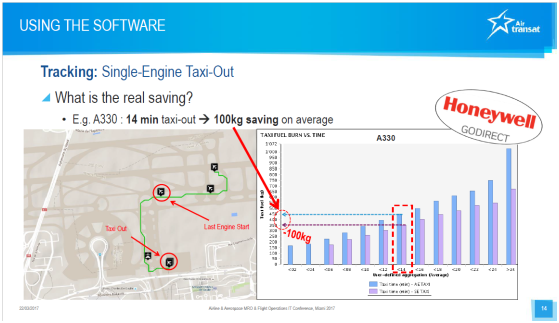
Figure 2
It shows the result for the A330 fleet depending on taxi out time; what is the average burn for an all engine taxi (blue) and what is the average burn for a single engine taxi (lilac)? If we compare the two lines for a 14 minute taxi out we can identify an average fuel saving of about 100kg. So this is using our actual data to prove and quantify the saving for this procedure and get results that can be shown to pilots to demonstrate the known value of single engine taxi out.
If we want to look at how often the procedure is being used we can use another graphic based on actual results (figure 3).
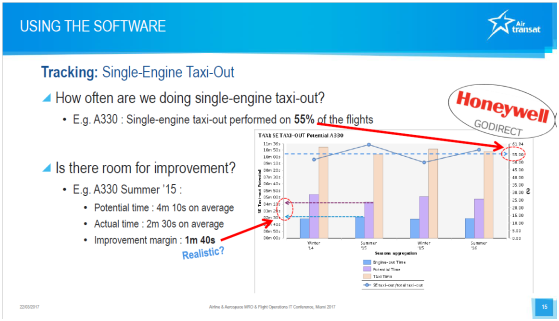
Figure 3
At the top of the graphic is the average utilization of the procedure which works out at 55% for the A330 fleet. This is a good rate with more than half of the flights using single engine taxi out but, now that we know the figure, we believe that it could be increased to around 60% which will be the short-term goal.
On the graphic, the longest bars represent the total taxi out time on average for this fleet in each season. The second (lilac) bar shows the potential portion of the taxi out time possible using just one engine. The different between the two is the time for the engine to warm up before take-off. If we look at our actual performance (blue) we can then see from the difference between the two, the improvement margin that it is possible to aim for. Of course, we don’t expect to realize the full potential every time but it shows pilots that there is this significant margin for improvement.
The software also lets us show that same result but by airports (figure 4).
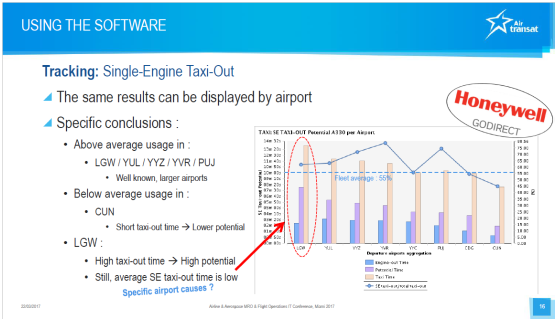
Figure 4
This allows us to arrive at specific conclusions about the airports into which we fly. So, looking at London Gatwick, Montréal, Toronto, Vancouver, Punta Cana, we know that these are large, well-known airports for which we see over average utilization of the single engine taxi out procedure which explains why these airports are doing well because pilots feel safe to do long single engine taxi outs. Looking at Cancun, we see that usage of the SE taxi out procedure by Air Transat pilots is below average but that’s because the taxi out is itself very short so pilots don’t feel there is the time to do it. This knowledge is really useful for the airline to understand what is happening and to talk with the pilots about these specifics. At London Gatwick there is a very long taxi out but the single engine taxi is short because pilots are not sure when they will be taking-off – ATC (Air Traffic Control) doesn’t give much advance warning; the uncertainty leads pilots to be cautious about using single engine taxi out.
Another tracking initiative is for take-off profiles. We already knew that the effect of retracting the flaps earlier in the take-off profile reduces the amount of drag and so also reduces fuel burned. The question was, how could we confirm and quantify that and how could we achieve it? In March 2016 (figure 5) we changed the procedure for the A310 fleet to get the acceleration height from 1,500ft to 1,000ft AGL.
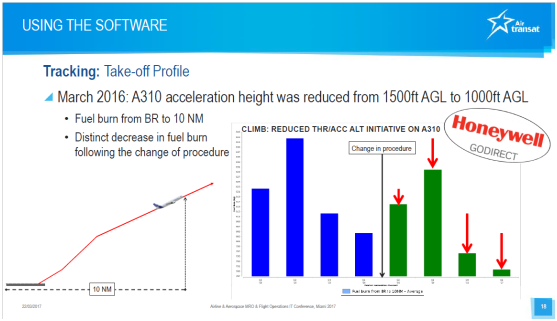
Figure 5
In order to capture the information to support that, we looked at the amount of fuel burned between brake release and 10 nautical miles of the airport to get a good idea of what the actual take-off profile would be and there was a straightforward analysis to undertake in the software. Right after we changed the procedure, there was a clear change in the average burn for that part of the flight and we could see that savings had been achieved.
Analyzing
As to how Air Transat uses the system to analyze things. Let’s start with the cost of weight as I’m sure that all readers will know about that – for every extra kilogram of weight that is transported over a period of time, there is a fuel cost. How can we use the software to evaluate this cost and to quantify the fuel savings? In the GoDirect software there is a built-in analysis to deal with COW (cost of weight) using the Breguet equation. So again, looking at the A330 fleet (figure 6) for a six hour flight we would get a 19% cost of weight and that’s calculated using actual data.
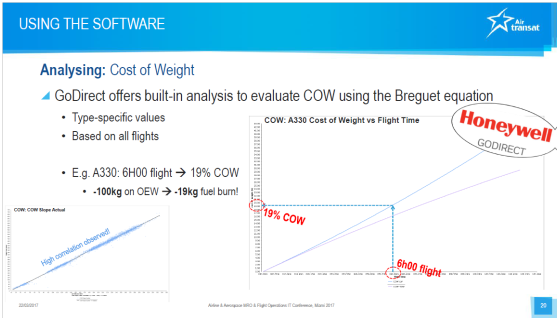
Figure 6
So, what is a 19% cost of weight? For example: if the operating empty weight (OEW) is reduced by 100kg, 19kg of fuel would be saved on a six hour flight. These are the types of things that can be used to realize potential fuel savings and is something that Air Transat uses every day with the fuel saving initiatives.
Discovering initiatives
Discovering new initiatives is what users really want to be doing with the software. Figure 6 shows just one example of initiatives that we have active at Air Transat and it’s about flight planning adjustments. Sometimes there are more direct routes available from ATC for the pilots to fly but dispatchers don’t know of it so they plan a longer route. As a result of this, the flight will use more fuel and have to carry more fuel which is, of course, more weight. The challenge is how to use the software to find more direct routes and to plan fuel savings. The example in figure 7 is about Cancun, one of Air Transat’s main destinations. Previously, arrivals in Cancun were planned using the MUXOG STAR (standard terminal arrival route) but that was not what the flights were actually doing.
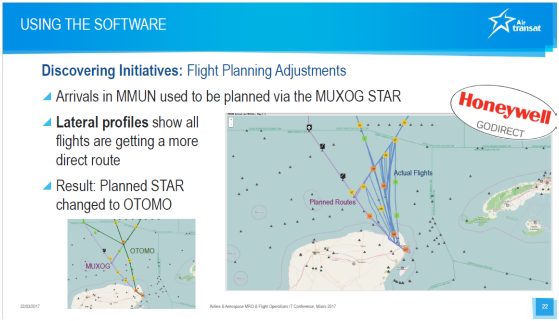
Figure 7
The MUXOG planned route is shown in purple whereas the actual flights are shown in blue and they were a lot more direct than the planned route. In that case, what we did was to show dispatchers the graphic. As a result, they changed the plan STAR to OTOMO which is what the flights were actually doing and which could save the fuel burned and carried on the aircraft. This is just an example of other things we can do to save even more fuel using our software.
Also with Cancun, we discovered that the actual flight planning was not sufficiently conservative and was giving a too direct route compared with what was actually happening. Pilots needed maneuvering distance when approaching this airport and that was not in the plans. So the plans were changed (figure 8)…
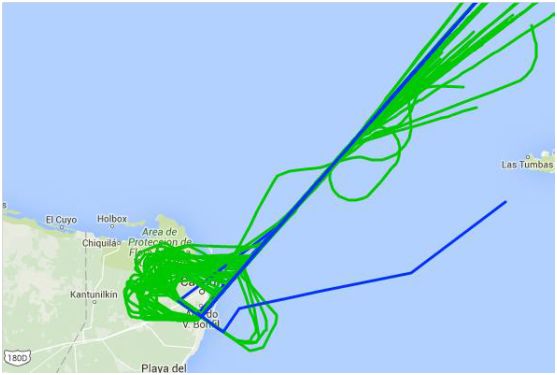
Figure 8
… to include a planned maneuvering distance which brought the airline’s planning (blue) closer to what was the actual fuel that was being used. It might seem odd to add fuel to a flight plan when the article is about fuel saving but the key to fuel efficiency is having the right fuel in the right place. If we want fuel efficiency to work in the long term, it is important that the fuel prediction is as accurate as possible as a sensible base from which to work on other things to reduce the amount of fuel such as reducing contingency fuel because there is a more accurate amount of fuel planned.
COMMUNICATING THE RESULTS
One thing that has always been made clear to pilots and other stakeholders is that GoDirect is not a disciplinary tool; it’s about everybody being equipped with the right information to inform their decisions and actions. At Air Transat we hold regular pilot meetings and that is the best occasion to discuss fuel with a pilot and show them some real-life examples to communicate our message and to get their reaction. This is the best way to get new initiatives underway and that’s what the airline has been doing for the past two years. We also use route fuel briefing for the main routes (figure 9) with the flight plans as part of the flight briefing package giving pilots fuel information such as trip fuel deviation giving the outliers and the average.
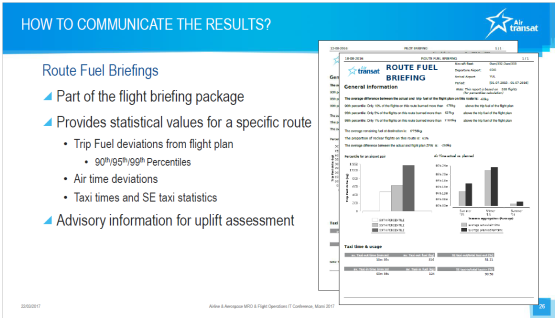
Figure 9
They also get air time deviations and taxi time statistics. As at the time of writing this is mainly advisory information to give pilots a better understanding of what is happening on the routes concerned so that they can assess their fuel uplift.
And we can use interactive dashboards to target specific audiences such as Engineering analysis, Pilots performance or Management overview to provide results for the fuel management program.
WHAT IS NEXT?
There are a number of plans for the future including:
- Personalized dashboards for flight crew so that they’ll be able to see what they have done and get sensitized to fuel efficiency.
- Flight planning improvements such as the things mentioned above, to make sure that, at all destinations, we are loading the right fuel for the right place by making route adjustments based on observed flights.
- A side project on which I have been working is the APM (aircraft performance monitoring) improvement through cruise analysis: using flight data to improve the evaluation of fuel factors.
- And finally, for contingency fuel using observed trip fuel deviation statistics as the basis for contingency calculation.
CONCLUSION
For Air Transat, the GoDirect fuel efficiency software has really been an eye opener. We are now able to track our fuel initiatives, we have a useful and powerful analysis tool, it helps us discover new fuel saving initiatives and it helps communicate the results and fuel efficiency information to all stakeholder involved.
Contributor’s Details
 Gabriel M. Blanchette
Gabriel M. BlanchetteGabriel M. Blanchette is a Flight Operations Engineering Specialist who has been with Air Transat since 2014 working on several projects mainly centered on fuel efficiency and aircraft performance. He currently manages the aircraft performance monitoring program for the Air Transat fleet. In 2015, he was part in the implementation of fuel efficiency software at Air Transat, and is now Fuel Efficiency Specialist. His past work includes Bombardier Aerospace and Pratt & Whitney Canada. Mr. Blanchette holds a Bachelor’s degree in Aerospace Engineering and is a licensed commercial pilot.
 Air Transat
Air Transat Air Transat is a holiday travel airline with a fleet of Boeing narrow-body and Airbus wide-body jets. The company was named Best North American Leisure Airline at the Skytrax annual World Airline Awards, 2015. Air Transat is also committed to reducing its ecological footprint, and has adopted an environmental policy.
Comments (0)
There are currently no comments about this article.

To post a comment, please login or subscribe.